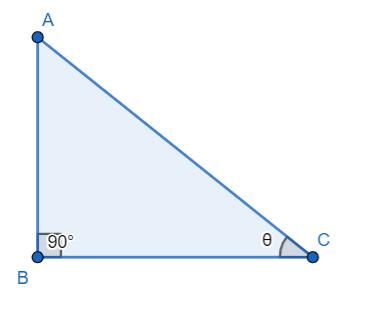
How do you prove
Answer
461.7k+ views
Hint: To prove this
Complete step-by-step solution:
In this question, we have been asked to prove that
For that, let us take a right angle triangle ABC.

In the above right angle triangle ABC, we have considered the right angle at B and
So we can say, AB is the perpendicular, BC is the base and AC is the hypotenuse of the right-angled triangle ABC.
Now, we will try to find or calculate
In the right angle triangle ABC,
As we know that
We can mathematically represent it as
Now, we will try to find or calculate
In the right angle triangle ABC,
As we know that
We can mathematically represent it as
Now, we will try to find or calculate
In the right angle triangle ABC,
As we know that
We can mathematically represent it as
Now, we will try to find or calculate
In the right angle triangle ABC,
As we know that
We can mathematically represent it as
Now, we will divide equation (1) by equation (2).
And we know that the same terms from numerator and denominator cancel out. Therefore, we get
From equation (3), we can write
Now, we will take the reciprocal of equation (5).
But from equation (4), we can say
Now, we will multiply equation (5) by (6).
And we can further simplify it as
Hence, we have proved that
Note: Whenever we get this type of problem, we will try to use the right angle triangle and then use trigonometry. We can also do this problem in one step because
Complete step-by-step solution:
In this question, we have been asked to prove that
For that, let us take a right angle triangle ABC.

In the above right angle triangle ABC, we have considered the right angle at B and
So we can say, AB is the perpendicular, BC is the base and AC is the hypotenuse of the right-angled triangle ABC.
Now, we will try to find or calculate
In the right angle triangle ABC,
As we know that
We can mathematically represent it as
Now, we will try to find or calculate
In the right angle triangle ABC,
As we know that
We can mathematically represent it as
Now, we will try to find or calculate
In the right angle triangle ABC,
As we know that
We can mathematically represent it as
Now, we will try to find or calculate
In the right angle triangle ABC,
As we know that
We can mathematically represent it as
Now, we will divide equation (1) by equation (2).
And we know that the same terms from numerator and denominator cancel out. Therefore, we get
From equation (3), we can write
Now, we will take the reciprocal of equation (5).
But from equation (4), we can say
Now, we will multiply equation (5) by (6).
And we can further simplify it as
Hence, we have proved that
Note: Whenever we get this type of problem, we will try to use the right angle triangle and then use trigonometry. We can also do this problem in one step because
Recently Updated Pages
Express the following as a fraction and simplify a class 7 maths CBSE

The length and width of a rectangle are in ratio of class 7 maths CBSE

The ratio of the income to the expenditure of a family class 7 maths CBSE

How do you write 025 million in scientific notatio class 7 maths CBSE

How do you convert 295 meters per second to kilometers class 7 maths CBSE

Write the following in Roman numerals 25819 class 7 maths CBSE

Trending doubts
State and prove Bernoullis theorem class 11 physics CBSE

What are Quantum numbers Explain the quantum number class 11 chemistry CBSE

Write the differences between monocot plants and dicot class 11 biology CBSE

Who built the Grand Trunk Road AChandragupta Maurya class 11 social science CBSE

1 ton equals to A 100 kg B 1000 kg C 10 kg D 10000 class 11 physics CBSE

State the laws of reflection of light




